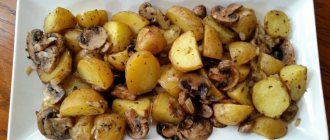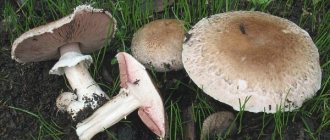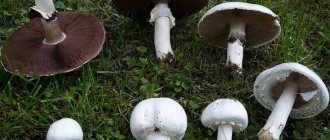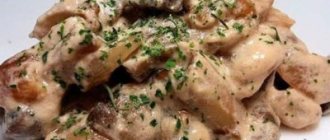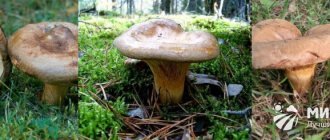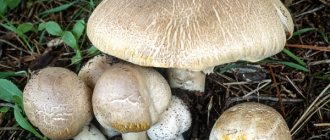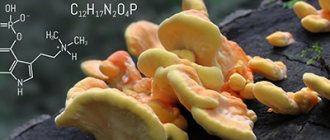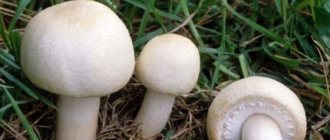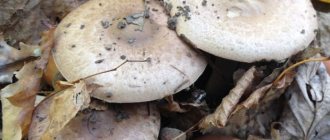Description
Field champignons, unlike their relatives, are considered large mushrooms. Their caps reach up to 20 cm in diameter, there are smaller specimens - from 5 cm. The sizes depend on the growing conditions. What it looks like:
It is not difficult to recognize a mushroom if you know its characteristic features. The shape of the cap changes over time:
- at the beginning of the growing season - round, bell-shaped with edges turned inward and a completely hidden hymenophore;
- in middle age it is half-opened;
- at the adult stage, it acquires a prostrate-convex state with a tubercle in the center (the edges are wavy or smooth).
The color of the cap is initially whitish-cream. Then it becomes ocher, since the surface contains tiny scales with a brown or brown tint.
Other distinctive features:
- Ring. When fully ripe it hangs down. It has a two-layer structure - the upper ring is longer than the lower one. There are often jagged edges or waves along the edges.
- Pulp. At first it is very compacted, but over time it loses its elasticity and softens. Color: white. But, if you break the mushroom or press on it, after 5–10 minutes the flesh turns yellow (this is a reaction to oxygen).
- Records. Planted frequently. They are distinguished by slight swelling. Width - from 8 to 12 mm. At a young age - white with a gray tint, then light pink, mustard, brown and even black.
- Leg. Its length ranges from 6 to 10 cm, its shape is cylindrical. There is a thickening at the base. A coating of flakes can be seen on it. Like the cap, the stem turns yellow when subjected to mechanical stress.
The taste of field champignon is sweet. Mushroom aroma with notes of almond or anise (more pronounced in young mushrooms).
What false champignons look like: photo and description of the appearance of mushrooms
Most often, the following representatives of the Agaricaceae family are mistaken for edible specimens:
- Agaricus xanthodermus.
- Agaricus meleagris.
- Agaricus californicus.
Typical examples of false champignons are shown in the photo.
A number of features will help distinguish such specimens from edible ones. On the cap of the poisonous double there is a brown spot, which is located in the center. If you press on it, light yellow spots will appear. But this method does not provide a guarantee, so it is better to use it in tandem with other signs.
When broken, the flesh of false forest and field champignons begins to turn yellow and smells unpleasantly of carbolic acid, and during cooking, the water and the mushrooms themselves turn bright yellow for a short time, but this color quickly disappears. Prolonged heat treatment will not rid the product of toxins.
Take a look at the photo and study the description of the appearance of false forest champignons.
The color of the cap and its shape can change under the influence of the environment, so special attention is paid to the pulp, its smell, shade and changes during cooking. Another mushroom that masquerades as edible is the toadstool
Outwardly, it resembles a champignon, but has no smell by which it could be recognized. There are volvas (root sacs) at the base of the toadstool, but people don't always notice them. If you have the slightest doubt about the suitability of the mushroom, you should break the pulp and see if it turns yellow, and then monitor the change in color of the water during cooking. This is one of the most accurate and proven ways to distinguish real edible champignons from false ones.
Another mushroom that masquerades as edible is the toadstool. Outwardly, it resembles a champignon, but has no smell by which it could be recognized. There are volvas (root sacs) at the base of the toadstool, but people don't always notice them. If you have the slightest doubt about the suitability of the mushroom, you should break the pulp and see if it turns yellow, and then monitor the change in color of the water during cooking. This is one of the most accurate and proven ways to distinguish real edible champignons from false ones.
Only a “young” pale grebe can be confused: over time, bulges will appear on its cap, it will become smooth, and the fringe will become saggy. The grebe appears from the first half of June, its growth peak occurs in August. The height of the toadstool can reach 20-25 cm, and the diameter of the cap does not exceed 15 cm.
Inexperienced mushroom pickers may mistake one of the light-colored fly agarics for good mushrooms. In this case, the unpleasant odor that the pulp has will protect you from poisoning.
If you don't know what poisonous false champignons look like, look at the photo: these are common mushrooms that are often mistaken for edible ones.
Spreading
The field champignon adapts to all climatic conditions. It is found in all regions of Russia. Unlike other species, it does not like to be near trees, but there is an exception - spruce or pine.
Favorite localization locations (they are easiest to find):
- forest glades and meadows, that is, places with a large concentration of herbal plants;
- roadsides;
- areas with cleared forest;
- parks, alleys and gardens;
- pastures;
- near the nettle thickets.
The mushroom grows in different ways - alone, in groups, with the formation of ruts or arcs.
Interesting Facts
Agaricus arvensis.
- Despite the fact that field champignon grows in open places, it can be found in light deciduous and even coniferous forests. It is capable of forming mycorrhiza with any trees, but never forms a root with spruce trees. It is also interesting that the mushroom has adapted quite well to climatic conditions, since it can be found not only in summer, but also in late autumn - until November.
- The mushroom is a gourmet variety and is suitable for almost any traditional dish. However, it can also be consumed fresh after boiling for a short time (10 minutes in boiling water). It has an interesting sweetish taste, not like the classic aroma of champignons.
Collection period and rules
The harvest season for field champignons is long - from May to November. The exact time depends on the climate (the warmer, the earlier). Experienced mushroom pickers prefer to collect mushrooms that are fully ripe, but not overripe.
It is easy to determine the optimal stage of growth: the blanket film is not yet fully opened, but is stretched to its maximum. The diameter of the cap is about 10 cm. In this state, field champignons have:
- strong aroma;
- pronounced taste;
- fleshy pulp.
How to assemble correctly:
- do not pick or pick up wilted/damaged mushrooms;
- do not roughly pull them out of the soil, otherwise the mycelium will die;
- cut with a sharp knife (it is optimal to unscrew it while holding it by the leg);
- fill the holes with earth, which will help the new crop grow faster;
- Place the collected specimens with their caps facing up (preferably in a wicker container (basket, basket)), which will allow air to penetrate between the mushrooms.
Champignon-like mushrooms with white plates
Some edible pecheritsa have very dangerous doubles. Thus, the common champignon can be confused with the toadstool. The species can be distinguished by the color of the plates (the edible one is pink, and the poisonous one is white), as well as the presence of a tuber.
Representatives of the white fly agaric can also be mistaken for field pecheritsa. Even experienced mushroom pickers usually cannot distinguish young fruits. And the species of adult mushrooms can be determined by the color of the lamellar layer.
Similar species
The field champignon has many varieties. Some of them are edible. “Relatives” are similar in many ways, but have different sizes, colors, etc. It is important to know about them, since there are also poisonous relatives.
Edible
There are many champignons that have a growing habitat identical to the field one, but the following species are most often found in Russia:
- Lugovoy. In appearance it does not differ from the field one. They recognize the double when it is broken - the flesh turns pink and then turns red.
- Crooked. The color of the cap is cream, the flesh is white. The size is almost 2 times smaller than that of its field relative. The main difference is that when pressed, spots of a very bright yellow hue are formed.
- Pereleskovy. The size of the cap is 2 times smaller, but the length of the stem is identical to its field brother. The pulp is thin and becomes ocher when cut. The smell is anise. Based on this feature, mushrooms are often confused.
- False value. Yellow-pink hat. The center of the dome is dark, the edges are light. The leg has white small scales on the surface. The smell of the mushroom is reminiscent of horseradish or radish.
Poisonous
Toxic twins in Russia are found in only two varieties. Poisonous and edible mushrooms are the same in shape and place of growth. Dangerous representatives of eukaryotes differ from field champignons in the following characteristics:
- Death cap. A very poisonous specimen. In appearance it resembles a champignon, but is distinguished by a swelling at the base of the stem, covered with the remains of a blanket. The ring is single-layer, located closer to the bottom. There is no anise or nut aroma. The plates are exclusively white. At the beginning of development, plants are confused.
- Red-haired. It differs from the field one in the color of the cap. It is yellowish, red or pink. On the leg (in the lower part) there is a brown swelling like a sac. When the fruiting body is broken, the pulp turns yellow at lightning speed. The peculiarity is the unpleasant smell of a pharmacy (carbolic acid).
Many new mushroom pickers collect all the mushrooms they come across in a basket. They are already sorting through the finds at home. This is fundamentally wrong. Picked toadstools release toxins from the cuts that can poison edible champignons.
Characteristic features of the variety
The champignon belongs to the Champignonaceae family. The fruit is also known as pecheritsa.
Appearance, description and photo
Nowadays there is no person who does not know what champignon looks like - since it is the most common mushroom sold in stores. However, you should understand that recognizing its forest counterpart is not so easy.
Depending on the type, the surface of the mushroom may be brownish or white. Young individuals form small smooth caps that are hemispherical in shape.
You may be interested in:How to recognize a mushroom with a cap and a white stalk: names and types (32 photos) Mushrooms are a wonderful culinary product, successfully used for preparing various dishes. The most…Read more…
As they grow, the caps of young individuals straighten and can take on a prostrate shape. In the center of the cap you can often notice a small convex tubercle. The skin is smooth, velvety and dry, often covered with small scales. All varieties are compact in size. For example, the diameter of the cap of a real champignon varies between 8-15 cm.
A distinctive feature of the species is the presence of a wide ring on the leg, which has an off-white or white color. The common champignon has a cylindrical stem. It is smooth, but widens towards the bottom. The diameter of the stem is 1-2 cm, and the color matches the color of the cap or is a shade lighter.
The white flesh at the break becomes reddish over time. It is meaty and has a pleasant aroma. It is worth paying special attention to the color of the pulp, because edible species have doubles.
The plates of a young mushroom are painted white, but as they grow, they first acquire a pinkish and then a light brown tint. The plates are rare, thin and not too long.
Place of distribution of champignons
This fruit is most common in the steppe and forest-steppe zones of Eurasia. The most diverse species of this fungus are found in open areas, meadows and prairies of Africa and Australia. In Russia, they should be looked for in moist soils that consist of a large amount of natural fertilizers and compost.
Mushrooms bear fruit generously in the Volgograd region. The most mushroom places are the following areas:
- Olkhovsky;
- Rudnyansky;
- Zhirnovsky;
- Novoaninsky.
They can be collected at the end of June. They are found near fir trees, in oak forests, in pastures and meadows.
You may be interested in:
Description and photos of edible mushrooms Mushroom pickers are not born, but become. You can master the complex science of edible and poisonous mushrooms at any age,...Read more...
Eating
The product can be safely consumed even in its raw form. This is the most common mushroom in Russia. Cooks have come up with many cooking methods. In addition, the product can be used by pregnant women and children.
Garden champignon
It is highly valued by vegetarians and people who want to lose weight. The calorie content of the pulp is very small, while amino acids, vitamins and minerals are contained in large quantities in the mushroom.
Nutritional quality and value
Field champignon is considered a dietary product. Its calorie content per 100 g is only 27 kcal. Nutritionists especially note its nutritional value:
- 4.3 g protein;
- 2.6 g dietary fiber;
- 1 g fat;
- 0.1 g carbohydrates;
- 91 g water.
The composition does not go unnoticed:
- vitamins B, A, E, C, PP, beta-carotene;
- microelements - iodine, chromium, cobalt, zinc, iron, fluorine, rubidium, molybdenum;
- macroelements - magnesium, calcium, potassium, chlorine, phosphorus, sodium;
- fatty acid.
Distribution area: Saratov, Samara, Lipetsk and Lugansk regions
The branch of science about mushrooms that studies their geographic distribution is called mycogeography and makes it possible to determine the places and areas where there are the most forest and meadow mushrooms in the territory of each region.
The distribution area of meadow mushrooms is very extensive and covers almost all soil and climatic zones of our country. The distribution area of fungi has a primary relationship with their food sources and partner plants. The climatic features of the region have a secondary impact on the number and area of distribution of meadow mushrooms.
Both edible and poisonous species grow outside the forest. When collecting meadow mushrooms, you should definitely learn to distinguish edible and conditionally edible species from inedible and deadly poisonous ones.
Of course, the most valuable from the point of view of nutritional value and taste are the porcini mushrooms themselves, which are often called meadow mushrooms, and boletus mushrooms. However, according to the observations of experienced mushroom pickers, forest mushrooms are of higher quality than those growing in the meadow, since they are less likely to be wormy.
Medicinal properties
Due to their rich composition, field champignons have a healing effect. They are used to make drugs. Recommended for use for the following diseases:
- diabetes;
- obesity;
- headache;
- problems with the kidneys, cardiovascular and nervous systems;
- tuberculosis;
- anemia;
- typhus;
- skin diseases;
- allergy;
- bronchitis.
Main properties of champignons:
- appetite suppression;
- acceleration of metabolism;
- improvement of visual acuity;
- normalization of unstable psyche;
- removal of cholesterol from the body;
- regeneration of damaged tissues;
- neutralization of bacteria and viruses;
- activation of the brain.
A special extract is isolated from mushrooms. It has a beneficial effect on hair growth, strengthening hair follicles and nail plates, improving the condition of the skin of the face and body. Lotions, balms, creams, serums, etc. are made from the extract. The cost of such products is high.
Benefit
Regular consumption of dishes containing field champignon:
- reduce the likelihood of stroke and heart attack;
- significantly increase performance;
- significantly improve brain activity;
- help improve visual acuity;
- normalize metabolic processes;
- improve the condition of the nervous system.
In addition, field champignons are actively taken by people who want to get rid of extra pounds or maintain an ideal figure intact, since after eating them a feeling of satiety is felt for quite a long time.
Harmful indicators of the fungus
Based on taxonomy, over a long growing season the mushroom accumulates heavy metals (copper, cadmium) and other toxins, that is, substances potentially dangerous to the human body. For this reason, it is not recommended to collect old champignons.
Specimens found on the territory of large production plants, near roadsides and garbage dumps are also harmful. Overeating worsens chronic diseases, especially gastritis and ulcers.
Contraindications:
- children's age - up to 5 years;
- problems with the digestive system;
- individual intolerance to mushrooms.
Edibility
The absolute safety of pecheritsa is a myth. Even people who consider themselves experienced and competent mushroom pickers should be extremely careful, since even those mushrooms that are considered edible are only conditionally harmless. Overripe, worm-eaten, damaged or excessively soft fruit bodies accumulate carcinogens and heavy metals, which can cause irreparable harm to health.
Important! You cannot collect or eat mushrooms growing in abandoned landfills, in industrial areas, near roads and wastewater treatment plants. Everything that grows in such an area actively absorbs toxic compounds in high concentrations and can cause serious diseases.
An indicator of the edibility of pecheritsa can be considered a change in the color of the pulp at the break. For safe mushrooms it should turn pink. There are also types of champignons in which the cut area turns red (two-ringed, forest, large-spored) or turns yellow (field and coppice). Mushrooms with a yellowing fracture are considered edible, but experts recommend not eating them often or in large quantities - they contain cadmium and other heavy metals in microdoses, but, accumulated in the body, they can provoke various ailments.
Storage methods
Field champignons are stored in different ways: frozen, dried, canned. They are pickled, fermented and salted, but the main requirement is the need for cooking. If the fruits are collected in ecologically clean regions, it is permissible to use them fresh.
Freezing
Champignons can be frozen boiled or raw. In the first case, they are considered ready to eat, in the second, after defrosting they will have to undergo heat treatment (cook/fry). The shelf life during such storage ranges from 12 to 18 months.
Peculiarities:
- packaging - plastic container, vacuum bag, regular bag;
- the rule is that you cannot freeze it twice, that is, after defrosting, you should immediately use the product;
- storage form - cutting into slices, cubes, whole;
- mandatory pre-treatment - after cooking or washing, a drying procedure is carried out on a towel;
- An acceptable measure is that it is not necessary to wash the mushrooms before freezing; just wipe with a soft cloth and brush (to remove dirt).
Pickling
Pickled mushrooms were considered the best dish in Rus', so the preparation method is still used today. The taste of champignons will be specific, but pleasant.
Ingredients:
- mushrooms - 1 kg;
- salt - 75–80 g;
- sugar - 30 g.
Recipe:
- Boil the champignons for 10 minutes. Drain in a colander.
- Place in a saucepan, basin, etc., add sugar and salt, mix thoroughly.
- Place a weight on top.
- Inspect the container after a day - juice should form. If there is none, add a little water so that all the mushrooms are covered with liquid.
Keep the basin at a temperature not lower than + 20°C, fermentation time - 7-10 days (optimally - 25-30). After a week, transfer the product to jars and transfer it to a cellar, basement, or other cool place. It cannot be stored for a long time. Need to use within 2 weeks.
It is strictly forbidden for people with high stomach acidity to eat pickled champignons.
Pickling
Marinated champignons are used as a snack. There are many recipes, but there is a universal and quick one. You will need the following components for 1 kg of mushrooms:
- water - 250 ml;
- salt and sugar - 1 tbsp. l.;
- vinegar (9%) - 5 tbsp. l.;
- garlic - 7–9 cloves;
- black peppercorns - 15–20 pcs.;
- bay leaf - 2–3 pcs.;
- vegetable oil - 2 tbsp. l.
Recipe:
- Place all ingredients in a saucepan.
- Put it on fire.
- After boiling, boil for 7–9 minutes.
- Place the mushrooms in sterilized glass jars, roll up, cool and refrigerate.
- Use within 12 months.
Drying
Dried champignons are used to prepare various dishes. From the ingredient crushed to powder form, delicious puree soup and sauce are obtained.
There is no need to wash mushrooms before drying. This will increase drying time. If the fruits are large, they are cut into slices and cubes.
Drying methods:
- In the oven. Arrange the mushrooms in a single layer on a baking sheet. Bring the oven to + 50°C. Keep for 6–7 hours. Then increase the temperature by 30°. Dry for another 19–20 hours. Follow the basic requirement - open the oven door slightly.
- In an electric dryer. The fastest way. Proceed according to the instructions for the specific device.
- On a thread. This is a long, natural process. Thread small mushrooms onto a thread whole, chop large ones. Hang in a dry, ventilated area. To protect the product from insects, cover with gauze. Champignons dry from 7 to 15 days, depending on weather conditions and size.
Shelf life is 6 months. It is customary to store dry mushrooms in bags made of natural fabric or glass jars.
Pickling
Salted champignons are used for preparing salads and as an independent dish for side dishes. You will need:
- mushrooms - 1 kg;
- salt - 5 tbsp. l.;
- sugar - 1–2 tsp;
- garlic - 8-10 cloves;
- dill umbrellas - 80–100 g.
What to do:
- Boil the mushrooms.
- Place all the ingredients randomly in one container.
- Fill with water until it covers all components.
- Cover with a lid or plate, lay down the oppression.
- Keep at room temperature for 24–30 hours.
- Transfer to the refrigerator for 7 days.
- Place in jars and fill with the resulting brine.
- For winter use, sterilize the container before placing in jars. Then roll it up. Store in the refrigerator: 2 weeks without sterilization, within a year - in treated containers.
If the mushrooms are too salty, soak them in plain water before cooking or serving.
Canning
This method provides for long-term storage - up to 6-7 months. Be sure to sterilize glass jars and sealing lids before sealing. For 1 kg of champignons, take the following:
- salt - 1 tsp;
- sugar - 1 tbsp. l. without slide;
- water - 250 ml;
- citric acid - on the tip of a knife;
- cloves, white and allspice - 7 pcs.;
- other spices - optional, optimally add thyme and rosemary (0.5 tsp each).
Preservation process:
- Mix water, mushrooms, salt.
- Boil until done.
- Strain. Set the mushrooms aside and place the liquid on the fire, adding all the other ingredients.
- Boil the brine for 5–10 minutes.
- Place the mushrooms in jars and pour boiling marinade over them.
- Roll up the lids and place upside down under the blanket.
Primary processing and preparation
You can prepare a lot of different dishes from field champignon - it is fried, boiled, pickled, salted, frozen for the winter. The mushroom goes well with meat, poultry, and is used to make salads and sauces. All kinds of fillings for pies and cutlets are prepared from it. It is considered one of the best-tasting mushrooms of this genus and is edible even in its raw form, that is, it can be fried or made into soup without prior boiling. But it is not recommended to consume it in large quantities, since it is prone to the accumulation of heavy metals, the excessive intake of which in the body can cause the development of certain diseases.
With a reasonable approach, this champignon can become a real decoration of the table - it’s not for nothing that it is considered a delicious mushroom. Collecting and preparing it is simple - the main thing is not to confuse it with poisonous representatives of the mushroom kingdom. It is best for novice mushroom pickers to consult with experts, if possible, before putting champignons in their basket.
How to process field champignon?
Before storing, if drying is not provided, field champignons are processed. What should be done:
- wipe off dirt from all sides with a rag and brush;
- cut off the ends of the legs and all damaged areas;
- rinse under running water, but do not leave the mushrooms in the water (they will absorb moisture and become watery);
- spread on a paper towel in a single layer to dry.
If the mushroom is not very young, experts recommend removing the film.
Harm and contraindications
Field champignon can bring not only benefits to humans, but also harm. This happens in two cases:
- when using low-quality forest fruits;
- in case of individual intolerance to this species or mushrooms in general.
In other cases, harm from field champignons is limited to overeating or the wrong combination of foods. This variety should not be combined with heavy foods for people with illnesses and children. The rest should eat mushrooms as a side dish for vegetables or lean meat.
Important! Contraindications to the use of field champignon are a person’s age under three years, as well as chronic diseases of the digestive system in an acute form.
How to cook?
Field champignons are easy to heat treat. Their structure is delicate and does not require long cooking. Cooking methods and features:
- Cooking. After initial processing, cook in lightly salted water for no more than 10 minutes. Once ready, immediately drain in a colander to drain completely.
- Frying. Boiled and raw products are suitable for frying. In the first case, it is enough for the mushrooms to be on the fire for 5 minutes, in the second, process for up to 15 minutes. Note: the frying pan should be on high heat.
To improve the taste during frying, add chopped onions, ground black pepper and a little dill.
Application
Field champignon is edible, and it is quite acceptable to eat it raw. Regarding taste, it belongs to the third category and is rightfully considered a delicacy.
Field champignon is actively used for cooking:
- seasonings;
- variety of dishes;
- conservation;
- sauces.
Young specimens are considered the most valuable, since their flesh is more tender and the smell is richer and more attractive. Adult mushrooms are best used for drying, frying and baking.
Did you know? The raw pulp of field champignon goes perfectly with freshly squeezed lemon juice or citrus zest, grated on a fine grater.
Is it possible to grow such a champignon?
Field champignon quickly adapts to all conditions: it is grown in personal plots, in the basement, in bags, boxes, jars, etc. The main thing is to collect spores.
For this:
- Find a mushroom in the forest.
- Pinch off pieces from it.
- Place them in a nutrient medium (make a mixture of 3.5 tbsp agar-agar, 1.5 tbsp oatmeal and 1 liter of water).
The mycelium will produce white threads in 10–12 days, after which it is transplanted to a permanent place.
How to plant in the garden:
- Sprinkle rotted manure or compost over the soil.
- Spread the mycelium. At the same time, do not uproot the vegetation or tear off the grass.
When growing in the basement, the basis is a similar sequence of actions, that is, placing the mycelium on the soil. Just adhere to the following conditions:
- air humidity - 85–90%;
- temperature - during germination + 15°C, after germination - + 20°C.
The first full harvest is obtained in 2–2.5 months.
Field champignon is a valuable product. It has excellent taste and medicinal properties. It is collected from the wild and grown at home. The main thing is not to make a mistake with the species representative. A careful study of the indicators of appearance and edibility will help you learn to distinguish field champignons from their poisonous relatives.
0
0
Copy link
Growing at home and in the country
The most common mushrooms have long been grown in greenhouses, basements and garden beds.
It is very important for them to prepare high-quality compost:
- Take 6 kg of straw and 4 kg of manure.
- Place everything layer by layer in the prepared hole.
- Water every day and turn with a pitchfork once a week.
- After three weeks the compost is ready.
The time may vary depending on the raw materials and air temperature, but as soon as the ammonia smell disappears, the mixture can be used. Compost is spread on the beds.
It is better to purchase the mycelium itself from a responsible seller.
When growing outdoors, you should choose the most shaded area:
- The soil is slightly fluffed up.
- Plants, grass, roots should be left, they will help the mycelium form.
- The surface is sprinkled with mycelium and covered with prepared compost.
- You need to water as needed.
The first harvest, as a rule, germinates after 2.5 months. Sowing can be done in spring, summer or autumn. In winter, the mycelium is covered with fallen leaves and pine needles.
Sanitation and hygiene
To preserve the harvest and prevent the development of diseases, especially if mushrooms are grown on an industrial scale, it is necessary to comply with hygiene requirements. List of recommendations:
- Employees have clean overalls.
- Regularly change filters in the air conditioning system.
- Prohibition on free movement between different premises.
- Disinfection of equipment before starting work and their subsequent washing.
- Purchase of special rugs located in front of the entrance door to the premises. Their daily disinfection.
- Careful removal of raw material residues after completion of each stage of work.
- Store cover material in a container with a lid.
- Monitoring the ripening of fruits with timely removal of infected bodies.
- Strict adherence to technological instructions at each stage of breeding.
- Use insect traps.
- Use chemicals against pests as necessary.
Compliance with basic standards will save the farmer from large losses.
At the summer cottage
To do this, you can use a greenhouse or organize an open-air garden bed. In the second case, the yield directly depends on weather conditions.
Open air
An open-air plantation is set up by choosing a site under the walls of a house, under trees or near a fence. Work begins as soon as the snow melts. The hole is dug to a depth of 50 cm, the optimal width/length is 1 m.
Using thick cellophane, a waterproof layer is created - with its help, moisture is retained and sudden changes in temperature are prevented. Then the pit is filled with substrate, it is slightly compacted and the mycelium is added according to the general rules. A polyethylene canopy is installed on top. Instead of a canopy, you can use straw to cover the bed (layer thickness is about 15 cm). The soil is regularly moistened.
In hot weather and with long intervals between soil moisture, mushrooms may stop growing, but when favorable conditions are restored, they appear again.
In the greenhouse
You can grow champignons in winter in greenhouses equipped with heating systems (water type is preferred). To maintain a humid microclimate, containers with water are placed inside at a distance of 1.5 m, and the substrate is moistened using sprayers.
To maintain a comfortable microclimate, the greenhouse is sealed in the fall - cracks are sealed with sealant, damage is sealed with tape, windows and doorways are sealed with sealing material and equipped with locking elements.
Assemble the second covering contour. It provides additional insulation and also muffles the sun's rays. If it is not planned to install an additional circuit, then the roof is painted with chalk, lime or covered with translucent artificial material so that sunlight does not cause burns on the mushroom caps.
First aid for champignon poisoning
When, after eating, a person feels that his stomach hurts from champignons, it is necessary to call an ambulance. Trying to treat poisoning yourself at home is prohibited. To alleviate the patient’s condition, first aid can be provided independently:
- Urgently rinse the stomach.
- Cleanse the intestines with an enema.
- Give sorbent drugs.
- Provide plenty of fluid.
You need to rinse your stomach immediately after the first signs of poisoning appear. This will help get rid of the remains of dangerous mushrooms and reduce the level of intoxication. Children under three years of age cannot carry out this procedure on their own; only specialists can do this
When washing, it is important that the person is fully conscious, otherwise there is a risk of choking on vomit.
This can be done using plain or salted water and a weak pink solution of potassium permanganate. The victim should drink as much liquid as possible, and then induce vomiting by pressing two fingers on the base of the tongue. The procedure should be repeated until the water leaving the stomach becomes clear.
It is possible to remove harmful substances and potentially dangerous microorganisms from the intestines only with the help of a cleansing enema. At home, ordinary boiled water is suitable for this, the temperature of which should not exceed body temperature. The process will have to be repeated at least 2-3 times.
It is recommended to take sorbents for any poisoning. They neutralize, bind and remove toxins and bacteria from the body, help eliminate diarrhea, reduce the level of intoxication and help restore fluid balance. Suitable:
Before use, you must read the instructions for use. The dosage is calculated individually, based on the age and weight of the patient.
After gastric lavage, the victim needs to drink plenty of fluids. Alkaline mineral water, weak black tea with a lot of sugar, and rose hip decoction are recommended. You need to drink in small sips and small portions to avoid new attacks of vomiting.
